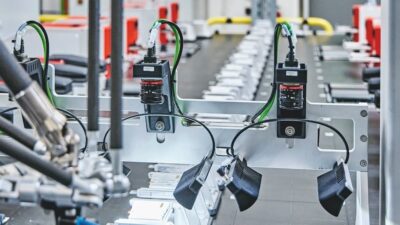Control Engineering begins its 51st year of publication with this issue. How much has changed in those first 50 years is hard to believe. Since most industrial controllers, whether for machine control, process control, or whole plant or enterprise control, are really dedicated computers, consider then a few of the changes in computer-based control over the past 50 years: Up next: multidimension...
Control Engineering begins its 51st year of publication with this issue. How much has changed in those first 50 years is hard to believe.
Since most industrial controllers, whether for machine control, process control, or whole plant or enterprise control, are really dedicated computers, consider then a few of the changes in computer-based control over the past 50 years:
As we were putting together our first issue, computers were analog descendants of World-War-II navigation and gunfire controllers, and based on ac synchronous motors, transmitters, and resolvers. Analog solutions ran in real time for the response of many mechanical and pneumatic control systems, and precisions of 0.01% could be achieved by analog computers.
We saw electronic digital computers coming as the means to match computing solution times to faster industrial control problems. So in 1955 Control Engineering editors started publication of two parallel series of articles on “Basic Digital Computer Theory” and “Digital Computer Applications in Control” that ran through 1956. But in 1955, IBM and Univac called their machines “electronic data processors,” not digital computers. IBM 700-series mainframes stored their data, and their programs for processing data, on punched cards. Electronic components were vacuum tubes. Compare mainframe-computing speeds quoted by IBM for the 700 series as “14,000 operations per second” with today’s claims for its fastest computers measured in terabytes per second. That’s a computing speed gain of a billion times in 50 years! We never would have guessed it would be that great.
In 1954, transistors had hardly been out of Bell Labs for six years, and they were still packaged individually in small cans and hand-wired into copper circuits electrodeposited onto fiber boards. Since then, printed circuit boards have led to application-specific microcircuits on silicon chips. Now, millions of individual transistors are manufactured at the same time on a single chip, all interconnected into a complete computer processor, memory included.
Magnetic tape data storage was just coming into early use, but long access times from one end of a tape to the other made tape drives too slow for random access to data in real-time control applications. Stacks of magnetic hard disks and floppy disks with moveable read/write heads and multiple data tracks were already in development that reduced average memory access times to a few milliseconds. Today, compact disks and digital video disks (DVDs) of much greater data capacity are used for program entry and problem storage on most of our personal computers. PCs now use much faster solid-state random access memories to run problems and process data, with data access times on the order of 10 nanoseconds.
Up next: multidimensional memory
Hindsight is easy if you have been there. Looking ahead, all you can say for certain is that we now have all the real gains of the past to build upon. So the gains in the future will be far greater than those highlighted above. About all we know for sure is that computer memories will be photonic and holographic. And we’ll start seeing them soon, within the next few months probably. They may start out being a little bit slower, but they will be accessing orders of magnitude more data stored in far less space with no moving parts and using far less power (no disks). Less power means higher reliability as well as long battery life. I’m certain you’ll find that a little research into holographic memory will be worth the effort. Do some Internet searches and follow the links. Then think!



